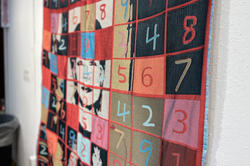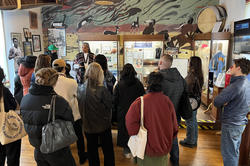Students enrolled in Jacquard Design engage with the textile industry’s complex past while skillfully crafting their own personal expression through the art of weaving.
State-of-the-Art Jacquard Loom Expands Possibilities for Weaving at RISD

In late August, after years of hard work and planning by over 20 RISD faculty and staff, along with alumni, industry consultants and engineers, the most advanced Jacquard loom on the market was installed in the Metcalf Building on North Main Street. The complexity of the installation—which involved building a “cage” of steel I-beams to distribute some of the weight of the loom to the walls, reinforcing the floor and taking measures to protect the building’s electrical and computing infrastructure—underscores the importance of the new loom to the Textiles department.
The cutting-edge Itema loom has novel capabilities, like weaving large textiles with a single image rather than a repeating pattern, and can incorporate complex structures across a continuous surface that allows fabric to take on a three-dimensional shape. With an unusually high number of weft (or horizontal-running) yarns, it enables students and faculty to create weaves with more variations in color, design and layers, says Polly Spenner 10 TX, the technician who operates and runs the loom (see top photo). It is also exceptionally fast. “The fabric almost pours out of the loom,” says Dean of Fine Arts Brooks Hagan MFA 02 TX.
“The flexibility of the equipment is extremely important,” Textiles Department Head Anna Gitelson-Kahn MFA 09 TX says. “It is industrial equipment, but we run it in a research and development setting. You never know what kind of project a student will undertake, and this loom accommodates endless possibilities.”

“The concept of binary encoding in this particular piece of equipment has become exponentially influential in our culture and in our lives.”
RISD has long worked with Jacquard, an automated form of weaving invented at the turn of the 19th century that is considered a precursor to modern computing. The threads used for each row of a weave were controlled by a series of punched paper cards. The presence or absence of a hole in the card determined the action of the loom’s warp and the overall pattern that was created, operating much like binary code.
“The concept of binary encoding in this particular piece of equipment has become exponentially influential in our culture and in our lives through really sophisticated fabrics, the abstraction of the process and computer programming,” Hagan says.
For many years, RISD was the only institution outside of industry settings where one could train on a Jacquard loom. Originally, RISD had a punch-card loom from the early 1800s. The new loom replaces the second, beloved Jacquard loom that enabled computer-aided design, Hagan says, and trained generations of alumni “who’ve gone into the field and done incredible things in weaving and adjacent mediums.”

The new loom is the next step in a long continuum of innovation in Jacquard at RISD, Anais Missakian 84 TX, Pevaroff-Cohn Family Endowed Chair in Textiles, says, and the importance of RISD’s program to the advancement of the textiles industry includes its equipment. Maintaining the original, antique loom was challenging and expensive, Hagan adds, especially as it became more difficult to find replacement parts or technicians to create the punch cards.
After the manufacturer stopped supporting RISD’s second loom, which was central to RISD’s rigorous Textiles curriculum for 25 years, Missakian and Hagan harnessed a team of faculty, staff, structural engineers, manufacturing partners and others to secure the new loom. Key players in the endeavor include Spenner, former Textiles Department Head Mary Anne Friel, Vice President of Campus Services Jack Silva, Director of Campus Planning Julia Parker, Design & Construction Manager Maria Smith, Tim Lopes of Shawmut Design and Construction as well as then Textiles faculty members Lisa Scull 82 TX, Susan Sklarek MFA 77 SC and Maria Tulokas MAE 74/MFA 76 PR, who nurtured the weaving program for many years. It was purchased with royalties from industry partnerships and support from the Pevaroff-Cohn Endowed Chair discretionary funds.
Now, Hagan says, students are eager to experiment with the loom, which will allow them to create banners, works similar to tapestries, graphically advanced weaves, origami-like fabrics with volume and more. “There are a million possibilities,” he says.
Gillian Kiley / images by Alex Pizzuti 17 FAV
January 22, 2024


